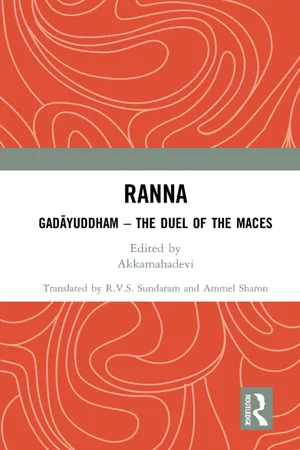
- 320 pages
- English
- ePUB (mobile friendly)
- Available on iOS & Android
About this book
The Gad?yuddham (The Duel of the Maces) is a k?vya (poetry) composed in classical Kannada literary style at the turn of the eleventh century. It is written in camp?, a genre that developed in the tenth century as a mixture of poetry and prose. Ranna's poem is remarkably dramatic in nature and is a meditation on the cost of war. Crisp dialogue, body gestures and imagery fill the poem. It is as if the poet were giving us directions for a play.
Ranna employs 'flashbacks', a technique called simh?val?kana, that is, a lion turning casually to glance behind him. Ranna builds up to the duel through characters recalling episodes of injury or through lamentation. The duel occupies only a short space in the eighth canto, but Ranna takes this time to fill in past episodes and reflect on the impact of war. This thousand-year-old poem will interest scholars as well as lay readers.
Please note: This title is co-published with Manohar Publishers, New Delhi. Taylor & Francis does not sell or distribute the Hardback in India, Pakistan, Nepal, Bhutan, Bangladesh and Sri Lanka
Frequently asked questions
- Essential is ideal for learners and professionals who enjoy exploring a wide range of subjects. Access the Essential Library with 800,000+ trusted titles and best-sellers across business, personal growth, and the humanities. Includes unlimited reading time and Standard Read Aloud voice.
- Complete: Perfect for advanced learners and researchers needing full, unrestricted access. Unlock 1.4M+ books across hundreds of subjects, including academic and specialized titles. The Complete Plan also includes advanced features like Premium Read Aloud and Research Assistant.
Please note we cannot support devices running on iOS 13 and Android 7 or earlier. Learn more about using the app.
Information
Canto One
Table of contents
- Cover
- Half Title
- Title Page
- Copyright Page
- Dedication
- Table of Contents
- A Note from the Kannada Language Chair
- A Note on Transliteration
- Introduction
- Canto One
- Canto Two
- Canto Three
- Canto Four
- Canto Five
- Canto Six
- Canto Seven
- Canto Eight
- Canto Nine
- Canto Ten
- Notes to the Translation
- Bibliography
- Appendix